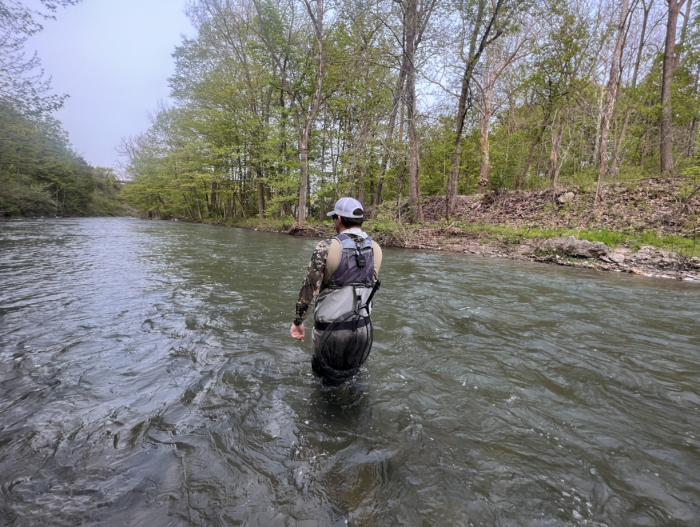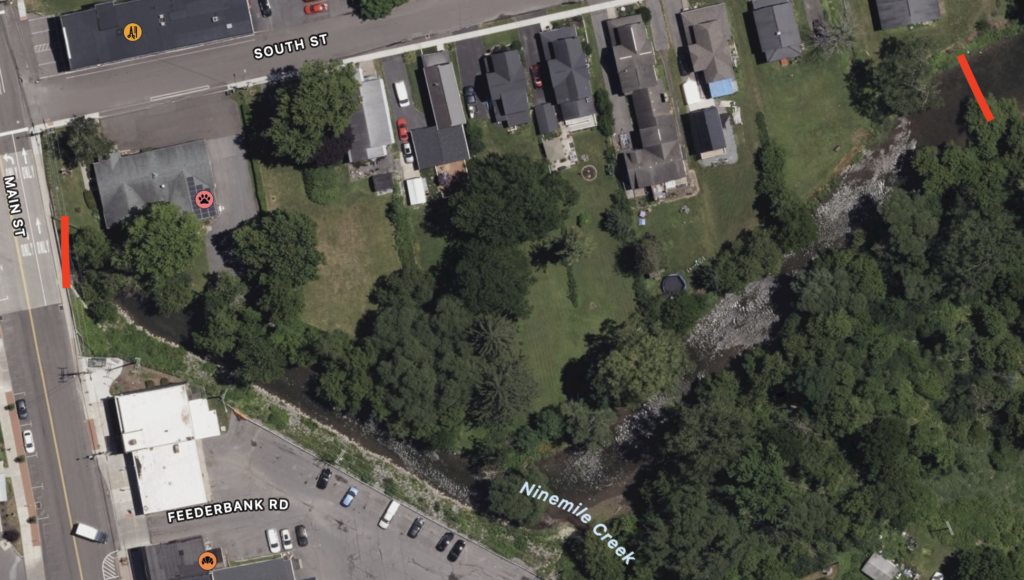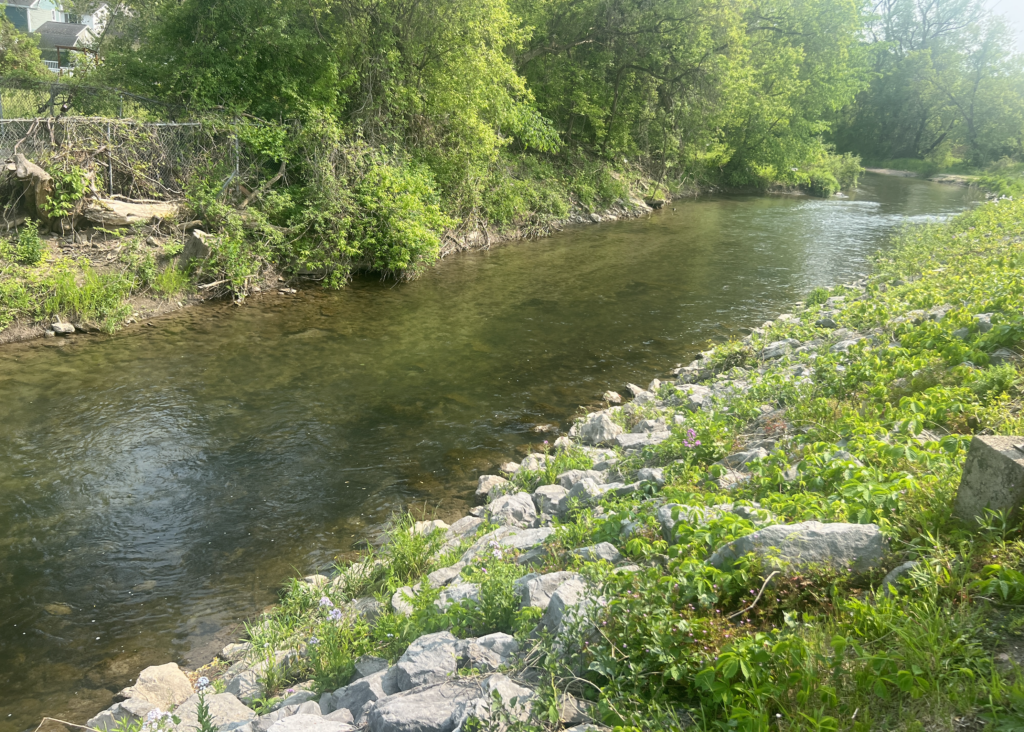
New York Regional Session Two- Lower Nine Mile Creek
This is part two of the New York Regional recap series. To read about session one, click here.
Lower Nine Mile was a hit or miss venue. We walked the beats in practice and all agreed they got significantly worse as they went downstream. Beats one and two were well structured, but the water got much flatter and siltier as you headed down towards beat six. The upper beats also got a few more stocked fish as they were right in town, while the lower ones were hard to access. I figured if you pulled beat six you were fighting for a five or six in the session while on beat one you were nearly guaranteed first.
Luckily for me, I pulled beat one. The beat started at a bridge in the middle of town, flowing between a steep landscape rock hill and a retaining wall for about a hundred yards before turning ninety degrees into a small neighborhood. Not only was it probably the best beat in the venue, but it was also a piece of water I was familiar with. Actually, I knew every seam, pocket, and depression on that water by memory. I also knew how many fish were there and expected to pull pretty high numbers.

I rigged up the same way as upper Nine Mile, with a T&T Contact II 10’9” 2wt and a micro leader of 0.18mm tricolored Sempe material. In competitions I change my micro leader every session, so this was a brand new one. I tied about 4.5 feet of Cortland 6x off a stopper knot to a 3mm silver beaded pheasant tail. The beat started with a large depression that was left behind when the township removed a downed tree earlier in the year. While rigging up I saw a small fish rising on the opposite bank where the tree used to sit. When the buzzer rang I threw some casts at it and was on the board in less than a minute.
After that I began focusing on the depression and quickly had another. After about fifteen more drifts and no fish I decided to switch it up and tied on a 3.5mm chartreuse mop. I immediately got three more, with one swimming a few feet out from under an abandoned tricycle to eat it. I continued working this tactic up the depression and picking up fish. When I got near the top I tied a 3.5mm beaded version of the pheasant tail on and ran it through. I got one or two but still wasn’t having the success I expected, so on one drift I stopped the fly halfway through and let it swing up. Evidently that’s what the fish wanted, because I caught another five in short order.

Above the depression the water shallowed to about three feet deep for twenty yards or so. When I got to this point another angler had gotten in about thirty feet above me and was working downstream with a spinner. I tried to fish as fast as possible so I could cover this water before he did. I made a lot of long sighter float drifts and far casts to likely structure on the far bank. There were a number of dinner plate sized depressions on the left side, and each one produced a fish as soon as the fly hit. I picked up a fish on about every third cast until I passed the spinner fisherman.
I skipped over the small section of water he fished and continued on using the same tactics a little more slowly. The water became more and more shallow until I reached the tail of the best run in the beat. This was just below the ninety degree bend, where the water turned into the opposite bank at an angle and went over a steep drop. I approached from the shallow side and fished it with the same fly on a higher angle drift. I was landing a fish every minute or two, with the limiting factor being how fast my controller could measure them. Luckily I was positioned only a few feet away from him and could have the fish scored as soon as they hit the net. When the action slowed I started trying to swing the fly up again, but the fish here didn’t seem to care for it. I put the chartreuse mop back on and got back into fish for a few minutes. I finally felt I bled that hole dry and moved on after landing around fifteen fish.

The water above the run was less featured, with a wide, relatively shallow depression running through the middle. I switched back to the pheasant tail and the longer sighter float drifts and picked up a handful of fish through it. In about twenty yards I came to a shallower run that flowed under a low hanging tree on the right bank. It had changed a bit since my last time there and I walked further into it than I should have, which probably cost me an extra fish or two. Luckily I still managed to pull four or five from the very head of it and missed a few more.
The deep side of the river switched to the left after that, with three good depressions spaced out between me and the top of the beat. I hit the lowest one first and pulled a number of good fish on the PT. I was going to jump right to the next depression, but to my surprise I started pulling fish from the shallower water in between as well. My thought is that they felt more safe sitting in it there because of the slightly increased tree cover and shade. By the time I got to the second depression I had already racked up about six fish.
The second depression was located right behind a small house with kids playing in the backyard. It was the deepest one and basically connected to the top depression.After landing a few fish from it I soon had a nice group of kids spectating me from the bank. I pulled a lot of fish out of these depressions on the PT, then switched to the mop and pulled a few more. I must have done a good job because when I came back to control the next session on this beat, all the kids were in the water trying to net the fish they now knew were there.

The last ten yards of my beat was frog water, and based on my success below I decided to skip it and head back down. Based on the rising fish I had seen and the number I got on a lifted fly, I decided to tie a PT back on and work down the beat swinging flies. I have never re-worked a whole beat like this in a comp, so it was a bit of a risk. Partly to my surprise, I picked up a number of fish on the way down. Most were small, but two scored. When I got back to the best run, I had about ten minutes left. I gave it some time with the nymph and a few passes with the chartreuse mop but had no action. I switched to a cream mop as a last ditch effort and got one more towards the drop off. With about five minutes remaining I put the PT back on and continued swinging downstream. I worked quickly down to the small section I had skipped after passing the spin fisherman. A few small fish grabbed my fly but I wasn’t able to score anything in those last few minutes.
When my controller called time, I had forty five fish on the board. Though this isn’t the most I’ve ever caught in a two hour session, it is the most I’ve caught where we had to measure fish. It’s hard to get much more than this unless you have a truly crazy beat where you don’t have to move much, just because it takes time to measure each one. This finish got me first in the session, with the next highest number being sixteen on beat three, and the lowest being only two fish on beat six. When the day ended, I was sitting in second place with only two placing points. After me, this beat put up seven, nineteen, and thirty fish. Based on how many fish I pulled from it, I was a little surprised to see that it didn’t win every other session on the venue. I would have put money on it, but I guess that just goes to show you can’t predict anything in this sport.
If you’ve enjoyed this series, stay tuned for part three late next week! For more information on Team USA Fly Fishing, visit their website here. If you’re interested in getting your feet wet (pun intended) in competitive fly fishing, you can find a list of upcoming competitions on Flycomps.com.

Thanks for the comp recaps, Mike. Your prose and photography are vivid and make the reader feel as if he’s there with you.
Now, for a oouple of questions:
1. I notice that you’ve gone the micro-leader route. In the past, you preferred stouter leaders. Could you explain why you’ve changed?
2. I have the Sempe stuff in .18 mm green and find it very hard to see. Is the tricolor easier to pick up? Or is just that I need better eyesight?
Finally, congratulations on your performance in the Interregional comp as well as the more recent mini.